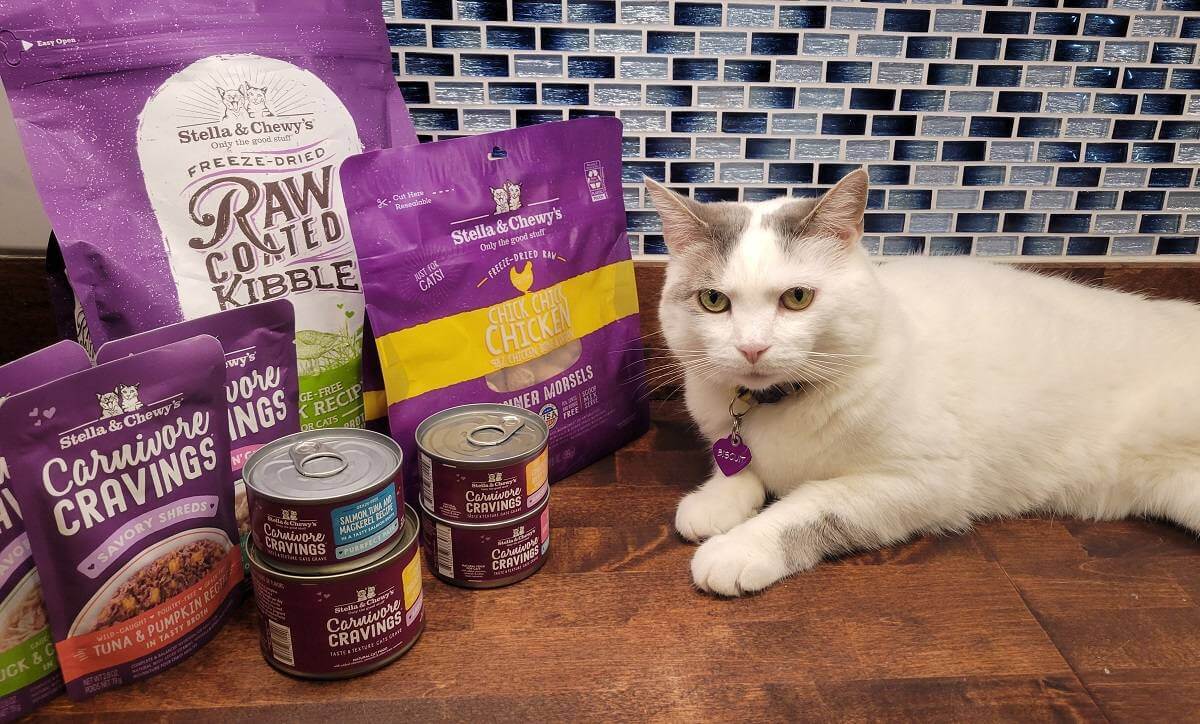
Kate Barrington / Cats.com
Stella & Chewy’s is a leader in the frozen and freeze-dried raw cat food space, but is it a safe, healthy choice for your cat? Find out in our unbiased Stella & Chewy’s cat food review.
The Cats.com Standard—Rating Stella & Chewy’s on What Matters
We’ve analyzed Stella & Chewy’s and graded it according to the Cats.com standard, evaluating the brand on species-appropriateness, ingredient quality, product variety, price, customer experience, and recall history. Here’s how it rates in each of these six key areas.
Ratings
- Species-Appropriateness – 9/10
- Ingredient Quality – 8/10
- Product Variety – 8/10
- Price – 5/10
- Customer Experience – 5/10
- Recall History – 4/10
Overall Score: 6.5/10
We give Stella & Chewy’s cat food a 39 out of 60 rating or a B- grade.
Why Trust Cats.com
Our cat food reviews are the product of extensive research and in-home testing. Before selecting products to test, we spend hours delving into the history of the brand, reading customer reviews, and reviewing the company’s website. We aim to cultivate an understanding of each brand and its reputation among cat parents before we put it to the test.
We’ve tested over a dozen products from Stella & Chewy’s various cat food lines over the years and we continue to revisit this review when updates are warranted. During testing, we evaluate objective factors like ingredients, nutrition, and manufacturing processes while our cats offer their opinions on subjective matters like taste, texture, and palatability.
We seek to provide a well-balanced summary of the brand and its products, taking both the positives and negatives into consideration, to help you assess its appropriateness for your cat.
Stella & Chewy’s Brand Overview
The Stella & Chewy’s story starts in 2003, shortly after company founder Marie Moody adopted an Airedale-Shar-Pei mix named Chewy. After Chewy was diagnosed with distemper, Marie started preparing a raw diet for both Chewy and her other dog, Stella.
In between jobs and inspired by the way her pups thrived on a fresh diet, she started delivering homemade raw food to pet guardians around New York City. The raw food was a hit with New York pet people and soon Stella & Chewy’s was one of the best-known raw pet food companies in the industry.
The brand continues to expand its reach, appearing in pet stores, groceries, and supercenters across the country. Though raw pet foods remain the focus of the brand, Stella & Chewy’s has responded to customer demand for cooked formulas including kibble and canned food, all made with the same premium ingredients.
Sourcing and Manufacturing
Stella & Chewy’s foods are made in the company’s FDA-inspected facility located in the Milwaukee, Wisconsin area.
The company sources ingredients from countries including—but not limited to—North America, New Zealand, and Australia. All of their fruits and vegetables are certified organic and sourced from either North or South America, depending on availability. Stella & Chewy’s doesn’t source any ingredients from China.
All of their foods are made using a patented food safety process the company calls SecureByNature®. This process involves high-pressure processing, which is a low-temperature process that leaves the food’s color, texture, flavor, and nutrient value intact while destroying pathogenic organisms.
After production, all Stella & Chewy’s products are subjected to testing by an independent lab. If you’d like to see the results for yourself, you can enter your Stella & Chewy’s product lot code and find the specific product’s safety results.
Recall History
Stella & Chewy’s was recalled twice in 2015. Both recalls were due to potential listeria contamination and affected food for both dogs and cats.
In 2025, Stella & Chewy’s released a statement to alleviate customer concerns about avian flu risks in relation to their raw pet food products. The company outlined its safety measures in detail and confirmed that no Stella & Chewy’s products had been affected by a then-recent recall of frozen raw pet food.
What Kind of Cat Food Does Stella & Chewy’s Offer?
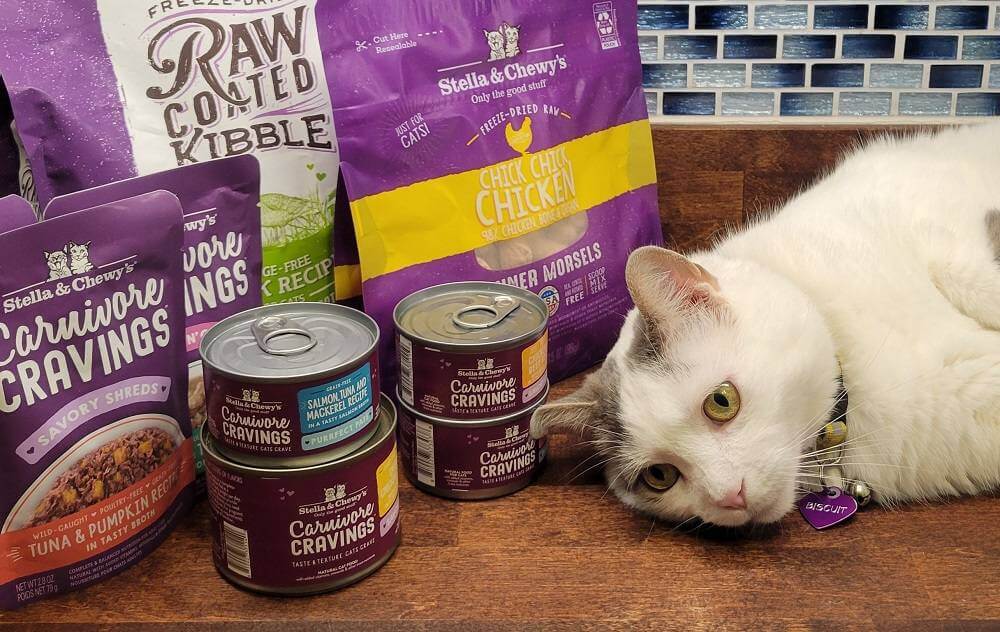
Kate Barrington / Cats.com
Stella & Chewy’s cat food selection includes freeze-dried morsels, raw-coated kibble, wet cat food, and freeze-dried raw treats. The brand discontinued its raw frozen cat food offerings but a quick-thaw replacement product is slated for release in 2025.
Perhaps the brand’s most popular offering is its freeze-dried dinner morsels. These are kibble-style chunks of freeze-dried meat that you rehydrate and serve. All of Stella & Chewy’s freeze-dried foods are at least 98% muscle meat, organs, and bones and come in the following flavors:
- Duck Duck Goose
- Bountiful Beef
- Absolutely Rabbit
- Plate Lickin’ Pork
- Chick Chick Chicken
- Tummy Ticklin’ Turkey
- Yummy Lickin’ Salmon & Chicken
For those not interested in raw feeding, Stella & Chewy’s offers an array of wet cat food products and a handful of raw-coated kibble recipes. Stella & Chewy’s wet cat food is divided into three product lines by texture: Purrfect Paté, Morsels ‘N’ Gravy, and Savory Shreds. The brand’s dry cat food has a freeze-dried raw coating and some recipes are blended with pieces of freeze-dried raw meat.
Stella & Chewy’s Cat Food – Top 3 Recipes Reviewed
| Product Name | Food Type | Price Per Ounce | Calories Per Ounce | Our Grade |
| Stella & Chewy’s Chick Chick Chicken Dinner Morsels | Freeze-Dried | $2.69 | 125 | B+ |
| Stella & Chewy’s Raw Coated Kibble Cage-Free Duck Recipe | Dry | $0.34 | 109 | B- |
| Stella & Chewy’s Carnivore Cravings Purrfect Paté Chicken & Salmon in Broth Kitten Recipe | Wet | $0.58 | 36 | A |
What Do Customers Think of Stella & Chewy’s Cat Food?
Let’s take a look at what some customers have to say about this brand.
Positive Reviews
Stella & Chewy’s cat food product listings receive almost exclusively positive reviews, with most customers saying their cats loved the food. Some say it helped to improve their cats’ health. Despite comments about the products’ high price tag, many customers think they’re worth the cost or use the product as treats rather than a staple diet.
“I purchased the Stella & Chewy kibble with morsels and noted that both cats ate the morsels before even touching the kibble. Since I need to take some weight off one of our cats, I ordered a bag of only morsels so I could cut down further on the kibble and increase their morsel intake. It is working, and the fact that they leave some food behind is a good sign they are not pigging out…..except on the morsels. I break them up a little and have not added any water to them….they like them dry. We found a sweet spot.” – Donna reviewing Stella & Chewy’s Chick Chick Chicken Dinner Morsels on Chewy.com, Jun 15, 2025
“My 2 Kitty Babies love it & I appreciate that is has very good ingredients with no fillers! All paws up!” – Lisa reviewing Stella & Chewy’s Chicken & Salmon Kitten Recipe Wet Cat Food on Chewy.com, Jun 23, 2025
Negative Reviews
Excessive bone content is the top complaint about Stella & Chewy’s cat food. Like some other makers of raw and freeze-dried food, Stella & Chewy’s cat food contains ground bone. Some say they use too much. Other negative reviews relate to cats’ refusal of the product or complaints about the price of it.
“Belle and Callie both give Stella & Chewy’s Duck Flavored cat food two thumbs down.” – Ben reviewing Stella & Chewy’s Cage-Free Duck Recipe Raw-Coated Kibble on Chewy.com, Jul 24, 2025
“Don’t feed raw food with this level of bone to older cats. Beware. Very hard on kidneys and I have lost multiple senior cats. Took me too long to realize it was the raw bone in this food. Raw mice bone is one thing – but raw chicken, turkey, salmon, etc- bone – cats wouldn’t eat this naturally. Very hard to digest and ok their kidneys.” – Shannon reviewing Stella & Chewy’s Chick Chick Chicken Dinner Morsels on Amazon.com, July 23, 2025
How Much Does Stella & Chewy’s Cat Food Cost?
Marketed as a premium brand, Stella & Chewy’s cat food is on the higher end of the price spectrum for similar products. Though most of the brand’s wet food and kibble costs under $0.60 per ounce, the freeze-dried products can cost up to $4 an ounce, depending on the flavor. In terms of freeze-dried cat food, however, Stella & Chewy’s is comparable to other brands like Vital Essentials and Primal.
Using a 200-calorie daily requirement for a 10-pound cat, we’d estimate the daily cost to feed your cat Stella & Chewy’s freeze-dried food to be about $4-$6, depending on the recipe. The brand’s kibble and canned food is more affordable, costing under $1 a day for kibble and $3-$4 for canned food.
Overall, Is Stella & Chewy’s a Good Choice?
Stella & Chewy’s is a leading option for those interested in feeding a raw or freeze-dried diet. The brand’s recipes deliver straightforward, meat-first nutrition without unnecessary additives or carbohydrate content.
However, the frozen and freeze-dried raw foods appear to contain too much bone. Because they contain so much bone, Stella & Chewy’s freeze-dried and frozen raw foods tend to be high in phosphorus and may not be a good choice for cats with kidney disease or those trying to minimize their cats’ phosphorus intake for any other reason.
If you’re looking for a more traditional diet, Stella & Chewy’s wet cat food appears to be a solid choice. There are several textures and an array of flavors to choose from, including variety packs that make it easy to sample the product without committing to a full case.
Where Is Stella & Chewy’s Cat Food Sold?
While most of the brand’s selection is sold online, you can only buy Stella & Chewy’s frozen foods at local pet stores. When the new quick-thaw frozen cat food morsels are released, they may be available for purchase on the brand’s website.
Outside the brand’s website, you can find Stella & Chewy’s products on Amazon and Chewy as well as other online retailers like Only Natural Pet, PetFlow, and PetSupermarket. You can shop in-store at major pet retail chains like PetSmart and Pet Supplies Plus as well as smaller regional or independent stores.
Similar Brands
Looking for other cat food brands similar to Stella & Chewy’s? Check out some of our other brand reviews.

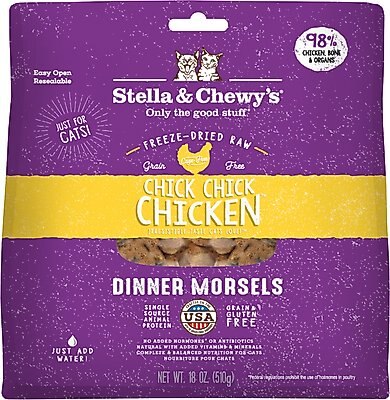
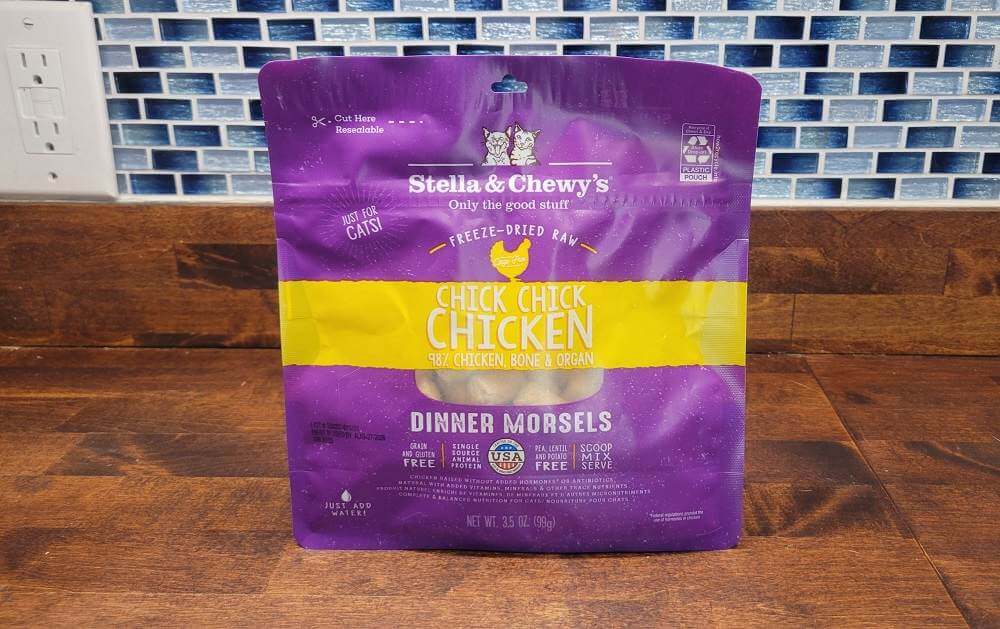
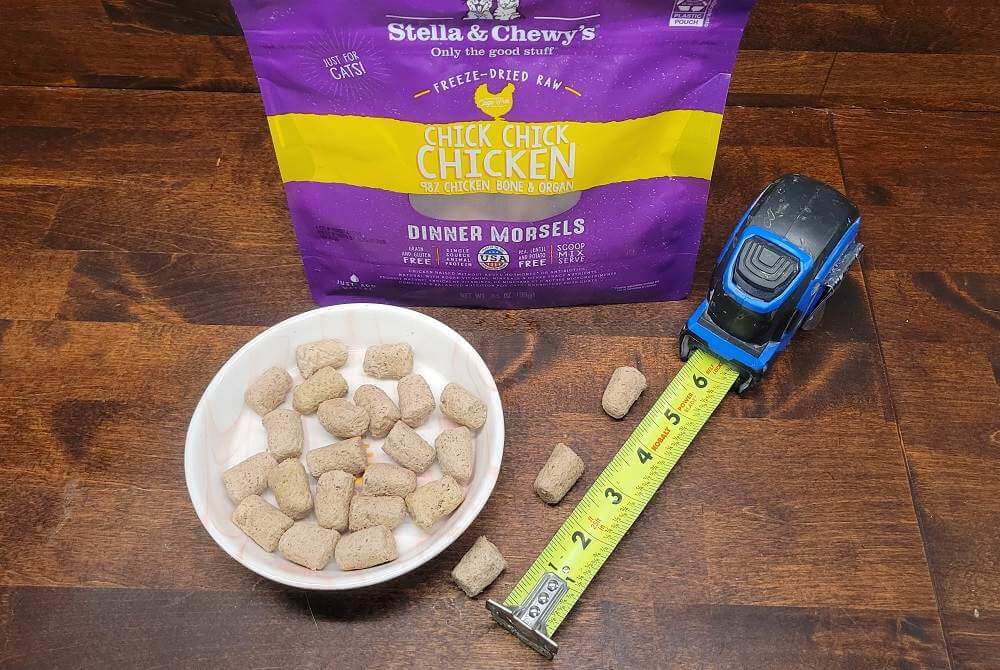
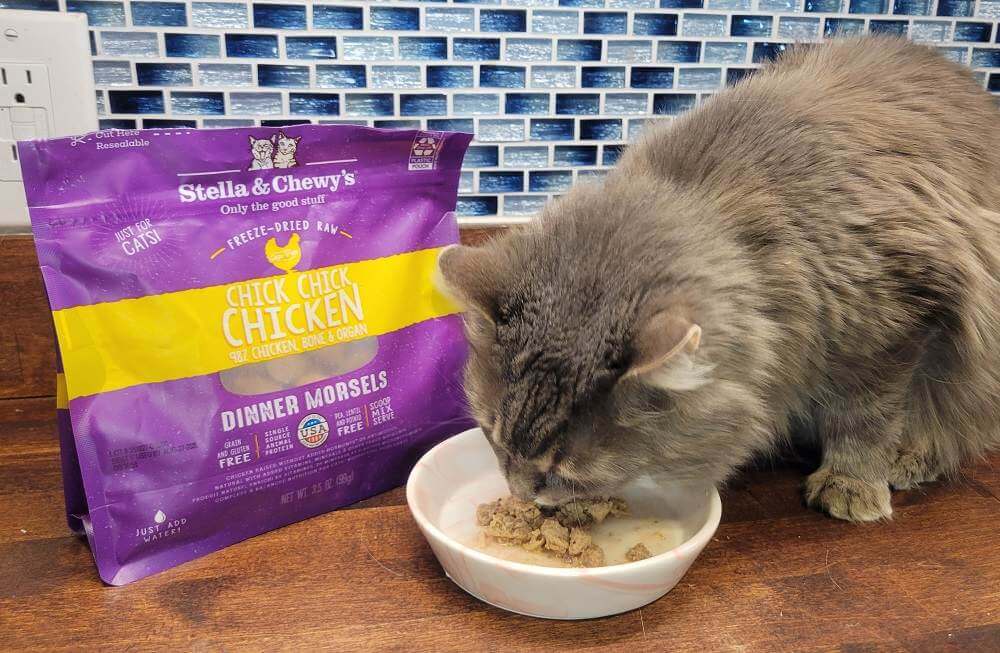

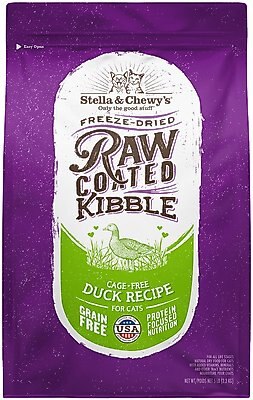
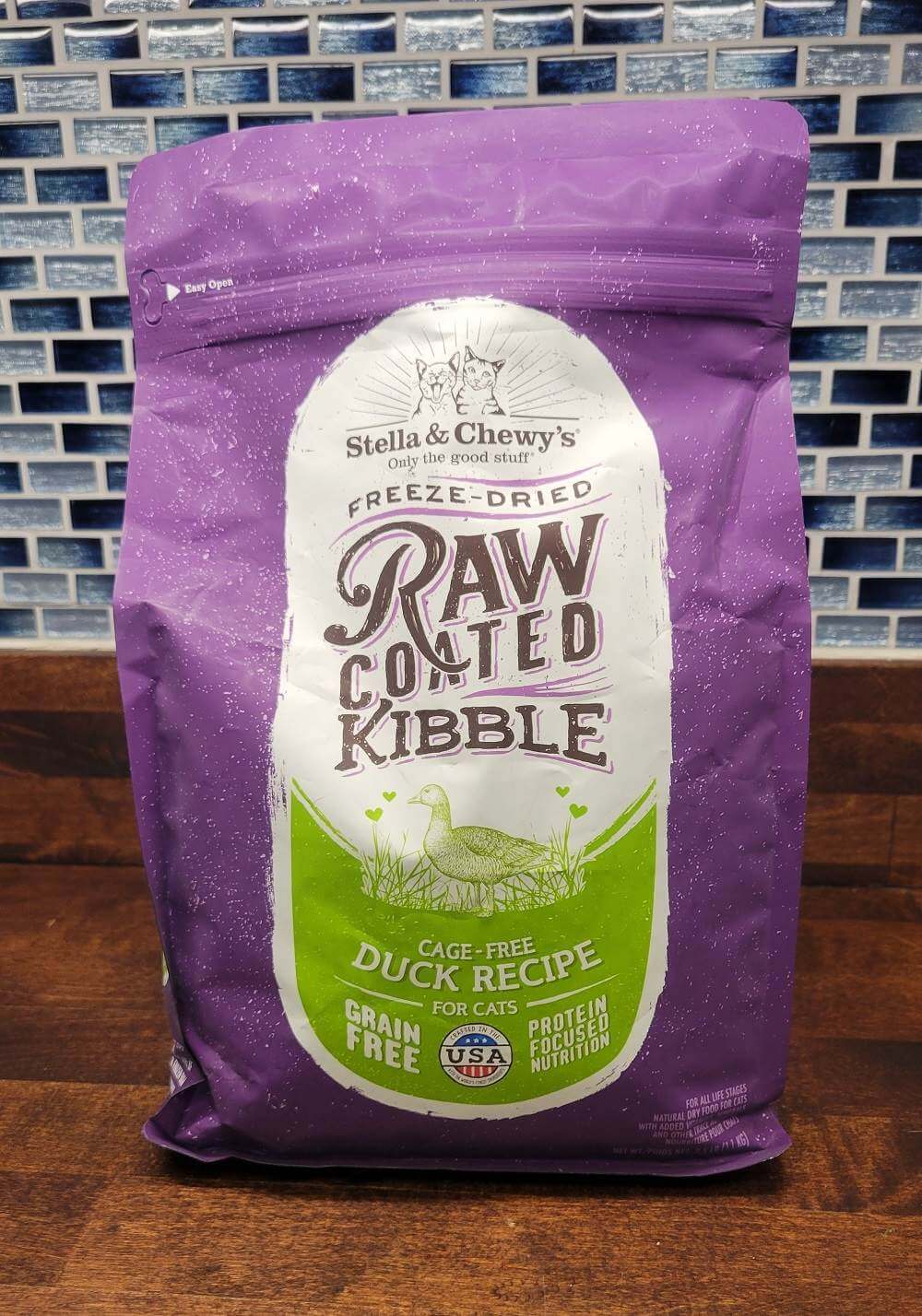
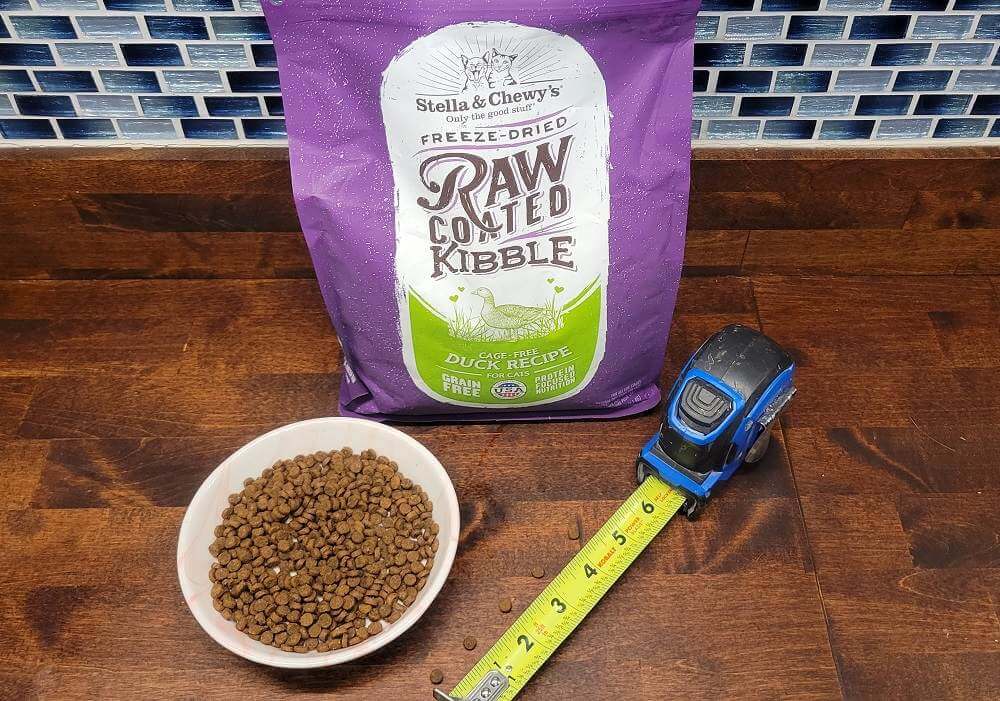
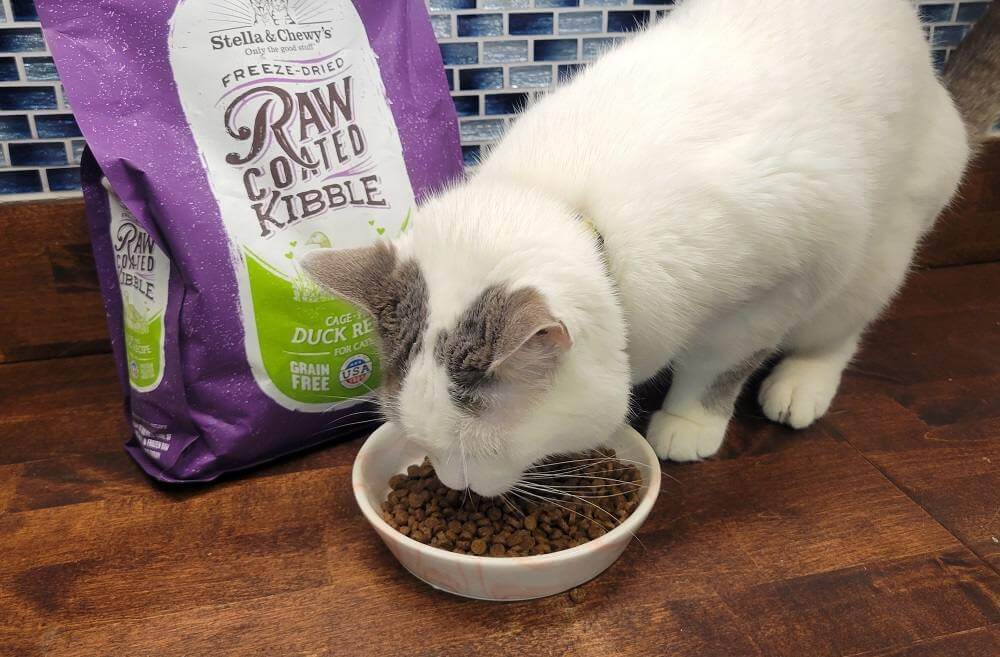
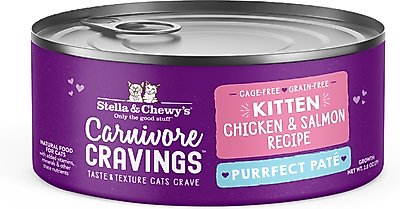
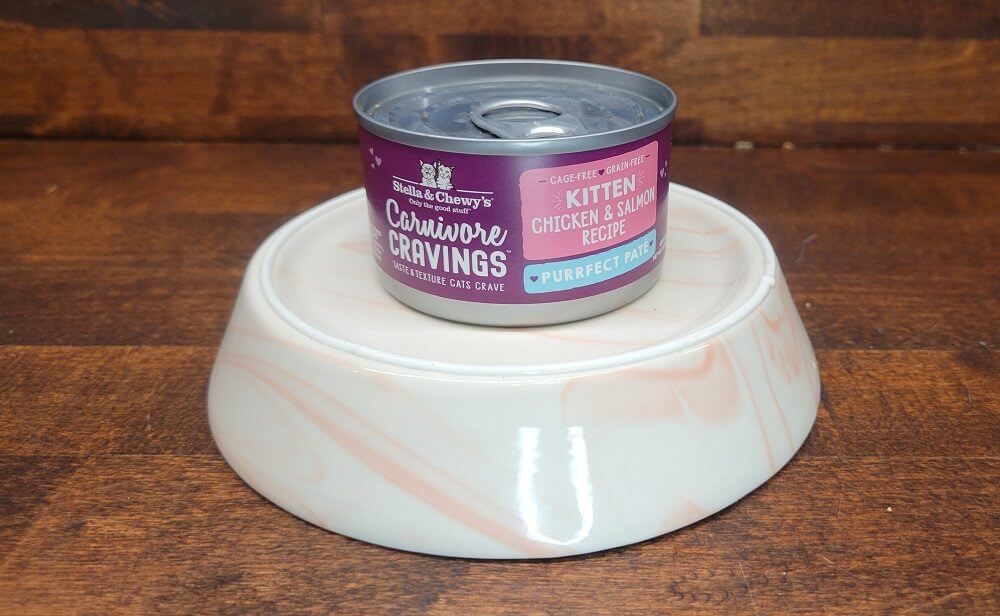
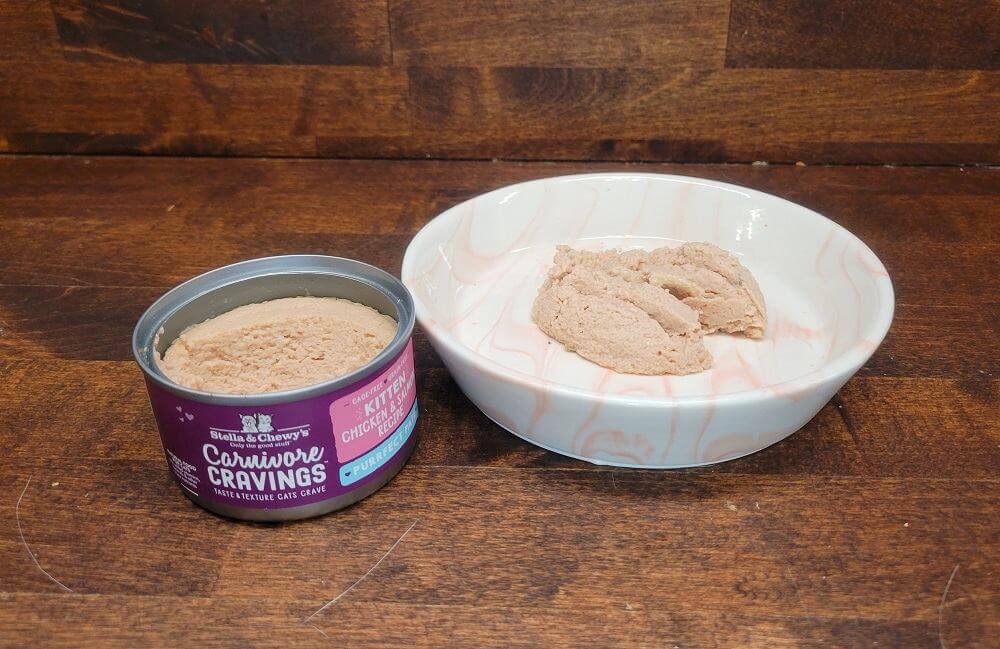
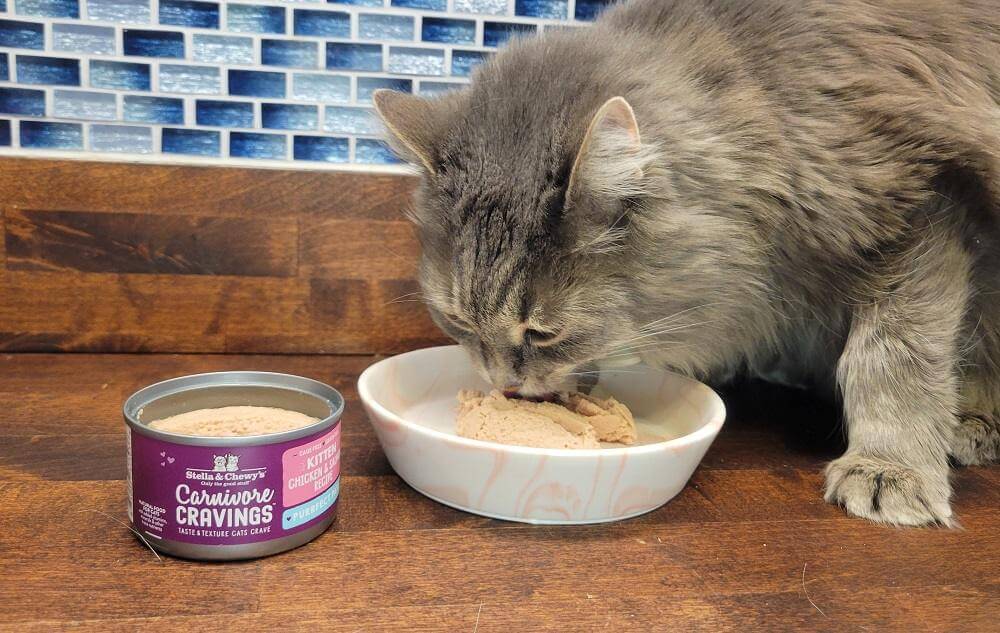
I was still waiting for the review of their wet foods 🙁 , how do you think these are as opposed to their freeze dried options ?
Is the phosphorus levels in the cage free chicken dry food too high for a male cat?
Hi Michael,
For the exact phosphorus levels for a given recipe we recommend contacting the company directly
So is the high phosphorus levels a big concern to feed our kitten full time as her primary food? She absolutely loves it and it is complete magic in terms of her bowel movements having absolutely no scent. We were having issues with wet foods and she’s not a big fan of dry food. Debating fresh frozen foods if this raw food is a health risk?
Hi Jake,
High phosphorus levels in cat food can pose a risk to kidney health, even in healthy kittens. In general Fresh frozen diets are less processed and may offer balanced nutrition with controlled phosphorus levels. If your cat is happy with the food, seems healthy and checked once a year with good results than I would not worry about it.
Hello and thank you for this great report ! Our kitty started 2 weeks ago slow introduction of the Plate Liking Porc as it seams to be the lowest in phosphorus . I have written to the company. But about after one week she started itching, scratching and biting, her face, back legs and mostly tummy . Are there any known allergens in these products ? I have tried to find more informations without success. THANK YOU SOOO MUCH !
Would love to see an updated review now that they have wet canned food for adults and kittens!
On our list!
Would love to see a review of their wet food! It has a decent price point and my cats like it.
It’s coming up in the next few weeks!
Would love to have a review of Stella & Chewy’s wet cat food! Thanks
On our list!
Hi Mallory, what are you thoughts on the Stella and Chewy carnivore cravings line especially the savory shreds mix, I buy this food for my cats but I can’t decide if it’s good or not.
Hi Berenize,
We like Stella and Chewy and recommend their recipes on multiple pages, the carnivore cravings looks good and same for the savory shreds mix so you should be good
Hi can you explain the lab report for this food , is there any harmful additives found in the food that i should be worried about?
This is a question. I give your freeze-dried raw salmon and
chicken dinner morsels, three or four a day, to my 4 year old
cat as a snack, in addition to his vet-prescribed diet.
He loves them and it seems to encourage his eating of
his routine diet. He usually goes to his water bowl after
eating his snack but not always. Is this ok? Is it ok if
I don’t hydrate the morsels?
The morsels are really dry, with even lower moisture content than a regular dry food, so what you’re seeing is kind of like you drinking some water after having dry crackers or popcorn. It’s not bad to give a dry treat once in a while, but it is ideal for cats to have a high-moisture diet overall.
I wonder about the Ash in the foods. How can this be acceptable? Is it a needed ingredient, or filler? They don’t list it on the packaging like I’ve seen in the past. THanks!
It’s neither, really—”ash” includes anything that isn’t organic in the food, e.g. vitamins and minerals. It’s not something that’s added to the food but a crude measure of the percentage of the food that is neither protein nor fat nor carbohydrates.
I have inherited all my cats by helping out the local representatives from feral cat societies. In the case of catching, fixing, and vetting momma cats with kittens, I try to keep them together when they get re-homed, but there seems to always be one kitten too smart or too squirrelly to catch. So after a year in the high desert, I have a cat again by default, and have converted my roommates into kitty lovers. She is quite the hunter, and before I switched her to Chewy and Stella (rabbit) two weeks ago, she was catching and eating wildlife (mice, rats, gophers, moles) every three days or so. I haven’t seen a single kill since I made the switch to Stella – which she LOVES by the way.
I’m curious as to why cat food is not made up of ground up rodents like bloodmeal, which is what zoo’s feed their cat species. Is it the “gross humans out” factor? In fact, I’ve been considering purchasing live mice at the pet food store and feeding one to my baby girl daily. She would love the thrill of killing her own prey as well. Any thoughts or suggestions on that idea?
Enna, that’s the question we should all be asking! So, there are a few companies exploring the option of using rodents in cat food, and there are a few reasons why it hasn’t taken off more than it has so far. One, and perhaps the main reason, is that it probably strikes a lot of cat people as being “icky”. Mice would not be considered a human food ingredient, and they’re not on the list of USDA-approved ingredients. Of course, that hasn’t stopped the industry from using plenty of other ingredients that couldn’t legally go on our own plates, but I think there is a perception issue nonetheless. The other reason is that it’s quite expensive to make cat food with these animals. That’s why forward-thinking companies like Muridae use turkey, chicken, or other meats as their first ingredient before mouse. A lot of cat food is made from slaughterhouse scraps, and a mouse-based food is kind of the opposite; you have to raise and slaughter 4+ whole mice per can, and there’s not much you can do with any scraps or waste product (to my understanding). You can read more about some of the obstacles and challenges for these brands here.
Regarding letting her hunt her own mice, I think that would be a very cat-appropriate idea. You might get some raised eyebrows, but I think you’d only offend human sensibilities, and it would be perfectly in alignment with the real “way of the world” for cats. Alternatively, you can buy pre-killed frozen mice from Hare Today and feed those. They also offer a lot of other whole prey options that are great for cats, like baby quail, chicks, rats, and bunnies.
Mallory, thank you so much for your informative reply. I know that many people feel that letting kitty outdoors is cruel but I like to accept them for the wonderful animals they are, and just try to add to their lives (as they do to mine!) Keep up the great work!
Whats the flavour of the freeze-dried food on the second Lab report ?
It’s their Absolutely Rabbit Dinner Morsels.
Hi,
Thank you so much for the analysis and review. I am wondering whether you folks can review some of their dry kibbles. My cats enjoyed their freeze-dried coated kibbles and seemed to have a very reasonable price compared to other kibbles.
Best
Very good idea. We’ll consider it! There are a lot of interesting raw kibble products out there that we haven’t covered yet, so I agree that it would be a good option to review.
I have always been confused about the kcals of the dinner morsels. I don’t give them to my cat every day, but when I do, it is 6-7 morsels, rehydrated for a main meal. I switch to these instead of some of his other wet food, that is lots of moisture, but not kcals. I like to keep variety in his diet. How do I figure the kcals of the morsels? Put them in a dry measuring cup before reconstituting them or a liquid measuring cup before adding water
You can use any sort of measuring cup you like, and the calorie content seems to be based on the volume of the dry food, not rehydrated with water. Hope this helps.
Hi! Thank you for your review. My cats are picky eaters, so they will only eat kibble. I found Stella and Chewy’s coated kibble, and I want to try it out because my cats are eating Chicken Soup for the Soul and don’t seem very energetic, and are always in grumpy moods since switching to that brand. Do you think it would be worth the switch?
Hmmm, I would first talk with a vet to confirm that these grumpy moods and reduced energy are related to the food. Stella & Chewy’s food might help, but I would also consider any of the options on our list of the best dry cat food on the market.
YOU DID NOT SPECIFY KITTEN FOOD…
Hello Chris, all of the Stella & Chewy’s foods listed here are formulated for all life stages, making them appropriate for both kittens and adult cats.
What I really want to know is do cats like it. Reviews can and are bought. I only care if cats like it, which you completely failed to cover.
As Bill had pointed out, the dry-freeze dinner morsels are much higher in calories than what the label states. 1kg has 4,440 kcal and the label states that 1 cup has 188 kcal, but this is incorrect, as a cup has about 120 grams or .12 kg. which has 533 kcal. Their label states that 3/4 cup should be fed to a 8 lb cat, which would be an insane amount of calories. Some of their packages expresses the calories per oz instead, in which case the morsels have 125 kcal per oz and given that 3/4 cup has about 3 oz of dry food, you’d be giving your cat roughly double the amount of calories per day.
Stella & Chewy’s tends to refer to the rehydrated quantity, which is likely the issue here—an excellent point to note.
Would you be able to review some of their canned wet food? Im thinking about feeding my cat the chicken and chicken liver pate and want to know you thoughts on it. Thank you!
I second this! I have been feeding the chicken pate and my cat likes it, but I would love to see a review about their pate food on here.
You can look up the safety report on the Stella and Chewy website by entering your food’s product lot number? But where is the lot number printed on the packaging? I couldn’t find it by examining the bag of food, and couldn’t find anything on the Stella and Chewy website that indicated how to find it. I’m looking at the Stella and Chewy Raw Blend for cats. No dice.
Good question, Doug! The lot number is simply a string of numbers and/or letters, so it can be tough to find. It’s typically found on the side or bottom of the package, often near the “best before” date. If you can find the date, the lot number should be the combination of numbers/letters printed nearby.
A 10 lb cat is a small female, and that’s $2.53 a day to feed?
Let’s say you have a 20 lb male. That’s $5.06 a day.
5.06 x 365 days x 20 years = $36,938
Got 2 males or 1 male and 2 females? $73,876
Got 2 males and 2 females? $110,814
That’s not including vet bills, litter, etc.
Generally, the average cat should weigh like 10-15 lbs, 20 is more for larger breeds like maine coons. but yeah, having multiple cats is expensive. It’s why I only have one, want to give the best life I can to her
Hi, I am trying to incorporate freeze-dried raw into my underweight, 13-year old kitty’s diet, and she loves both Stella and Chewy’s and Primal and they’ve helped her reach a healthier weight. Anyway in deciding which to settle her in to, i wanted to take phosphorous into account as a old-cat precaution, and came here because you guys do such thorough reviews. it confused me though, as to which has less…am i just missing something? Perhaps i am just not understanding the following text excerpted from the 2 reviews (and of course it’s hard to find this info on Stella’s!, in search of clarity!). thanks!
primal:
Primal products tend to be relatively high in phosphorus, with typical phosphorus content around 1.0% or roughly 2 grams per 1,000 calories. That’s close to the recommended amount for growing kittens and certainly too high for a cat with kidney disease.
stella:
The company claims that all of their freeze-dried and frozen foods have the same phosphorus content. That’s 0.45% to 0.67% on an as-fed basis. Tummy Ticklin’ Turkey frozen raw food, for example, is 0.61% phosphorus on an as-fed basis. This translates to roughly 3.9g per 1000 calories. That’s twice the AAFCO’s recommended amount for growing kittens.
The percentage looks higher on Primal food due to the fact that it’s measured on a dry matter basis, not “as-fed”, but Stella & Chewy’s food definitely seems to be higher in phosphorus. The grams per 1,000 calories value is more reliable than the percentage.
I found that Stella and Chewy’s Shreds are also VERY high in calcium, which is another issue to watch when it comes to oxalate crystal formation and kidney stones. They told me that they follow AAFCO’s guidelines, but in actuality, their calcium level is TWICE what the AAFCO recommends for Adult cats. When I pointed that out to them, they just kept repeating that the add extra calcium because it is good for the cat. This seems to mirror their excess of bone meal (bone), which is also made of calcium.
As a result of them not being at all interested in my feedback, or attentive to this genuine concerns, I have cut way back on feeling my kitties their foods.
Trying to find high protein low carb food for my cat diagnosed with asthma a d rninitis. On dry food now would like to transition to wet.
Thanks for your reply. My cat is currently eating a mix of Sheba perfect portions wet food and blue wilderness chicken crunchy food. I’m looking for a healthier crunchy food, if I’m understanding correctly the blue wilderness stuff isn’t bad but it’s not particularly great either. I looked at every pet store near me trying to find Dr Elseys Clean Protein and none of them carried it. Might have to order online.
He is VERY picky, I’ve been trying to get him on 100% wet food but he just can’t shake the kibble. He doesn’t like any change in his diet, I’ve tried multiple high quality wet foods and he won’t eat anything besides the Sheba.
Hi, what do you think of the Freeze Dried Raw coated kibble options from them? Are they a decent buy?
Hi Seth, that’s a great question! Their raw-coated kibble is okay. The carbohydrates are still high, but you’re getting nice meat-heavy nutrition with a boost from the raw coating. That said, I wouldn’t really recommend it unless your cat absolutely refuses to eat anything but kibble. I’d rather see someone feeding 50:50 raw and kibble, though—at least they’d be giving their cat a moisture boost that way.
I have been in touch with customer service from this company for the last week. I requested the full analysis for the raw coated kibble, as they do not state the carb content anywhere. The representative that I emailed was extremely helpful and sent the requested info to me. I found the carb count to be terribly high – over 25% – and the rep replied that it was higher due to being ‘kibble’ that needed carbs to hold together. I stated that I do understand that, but I can buy Purina with a lower carb content, so all the raw in it was sort of wasted since high carb diets will result in a cat who is diabetic. They asked for a copy of my invoices, which I sent to them. They are sending vouchers for the entire 25lbs of kibble that I have on hand.
So, while customer service has been lacking in the past, I think it is great now. Since my kitty loves the freeze dried nuggets, I will drive the 50 miles needed to reach a pet store that carries them and hand select based on how many are broken down to powder. Kitty will not eat the dust mixed with warm water at all. So, my experience was very positive!! And I will stand up for their service now as being superb.
Thank you so much for sharing your experience—it’s very good to know that the customer service seems to have improved.
Thanks Mallory! Stella & Chewy seem to have a conflict of their own.
Their support person didn’t seem to understand the issue I tried to relay.
The medallions recommendation for a 14 lb cat was 7.5 (23 cal) medallions totaling 173 calories which matches most sites range for an adult cat. However their morsel products recommend 1.25 cups totaling 528 calories. (423 per cup) That makes no sense, and one fat cat.
Thanks again,
Bill-
Odd, indeed. I’m not too surprised—in my experience, Stella & Chewy’s doesn’t have the strongest customer support chops. At the end of the day, the per-ounce values are what matter, and you can use a scale to eliminate issues coming from variations in volume. Thanks again for pointing out this issue. It was an easy enough fix and makes the article a lot more useful/credible.
Have a good one!
You make it hard to compare their products. You list some by calories/oz, others calories/cup.
Also, you liked the ingredient pumpkin seeds in two of the three, didn’t like it in the remaining flavor.
Bill, thanks for pointing this out. I’m editing the piece now to make it consistent. Thanks.